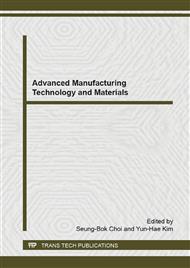[1]
E. Sachs, M. Cima, P. Williams, D. Brancazio, and J. Cornie: J. Manuf. Sci. Eng. Vol. 4 (1992), pp.481-488.
Google Scholar
[2]
Min Lee, James C.Y. Dunn, and Benjamin M. Wu: Biomaterials Vol. 26 (2005), pp.4281-4289.
Google Scholar
[3]
E. Sachs, M. Cima, and J. Cornie: CIRP Annals - Manufacturing Technology Vol. 39 (1990), p.201–204.
Google Scholar
[4]
A. Butscher, M. Bohner, S. Hofmann, L. Gauckler, and R. Müller: Acta Biomaterialia Vol. 7 (2011), pp.907-920.
DOI: 10.1016/j.actbio.2010.09.039
Google Scholar
[5]
W. Z. Wu, P. Geng, J. Zhao, Y. Zhang, D. W. Rosen, and H. B. Zhang: Materials Research Innovations Vol. 18 (2014), p. S12-S16.
Google Scholar
[6]
C. W Rowe, W. E Katstra, R. D Palazzolo, B Giritlioglu, P Teung, and M. J Cima: Journal of Controlled Release Vol. 66 (2000), pp.11-17.
DOI: 10.1016/s0168-3659(99)00224-2
Google Scholar
[7]
A. Butscher, M. Bohner, S. Hofmann, L. Gauckler, and R. Müller: Materials Science and Engineering A Vol. 298 (2001), p.110–119.
Google Scholar
[8]
D. Dimitrov, W. van Wijck, K. Schreve, and N. de Beer: Rapid Prototyping Journal Vol. 12 (2006), pp.42-52.
DOI: 10.1108/13552540610637264
Google Scholar
[9]
B Utela, D Storti, R Anderson, and M Ganter: Journal of Manufacturing Processes Vol. 10 (2008), p.96–104.
Google Scholar
[10]
I Zein, DW Hutmacher, KC Tan, and SH Teoh: Biomaterials Vol 23 (2002), p.1169–1185.
Google Scholar
[11]
A Simchi, F Petzoldt, and H Pohl: Journal of Materials Processing Technology Vol. 141 (2003), pp.319-328.
Google Scholar
[12]
D Cormier, O Harrysson, and H West: Rapid Prototyping Journal Vol. 10 (2004), pp.35-41.
Google Scholar
[13]
JP Healy, D Pletcher, and M Goodenough: Journal of Electroanalytical Chemistry Vol. 338 (1992), pp.155-165.
Google Scholar
[14]
L Benea, PL Bonora, A Borello, and S Martelli: Wear Vol. 249 (2001), pp.995-1003.
DOI: 10.1016/s0043-1648(01)00844-4
Google Scholar
[15]
SC Wang, and WCJ Wei: Materials Chemistry and Physics Vol. 78 (2003), pp.574-580.
Google Scholar
[16]
XM Shen, M Nagano, WQ Peng, YF Dai, and K Yamamura: Key Engineering Materials Vol. 523-524 (2012), pp.276-280.
Google Scholar
[17]
XM Shen, YF Dai, WQ Peng, M Nagano, and K Yamamura: Key Engineering Materials Vol. 516 (2012), pp.504-509.
Google Scholar
[18]
TFM Chang, T Shimizu, C Ishiyama, and M Sone: Thin Solid Films Vol. 529 (2011), pp.25-28.
Google Scholar
[19]
SK Cho, MJ Kim, and JJ Kim: Electrochemical and Solid-State Letters Vol. 14 (2011), p. D52-D56.
Google Scholar
[20]
M Xiao, M Cheng, Y Zhang, and F Shi: Small Vol. 9 (2013), pp.2509-2514.
Google Scholar


